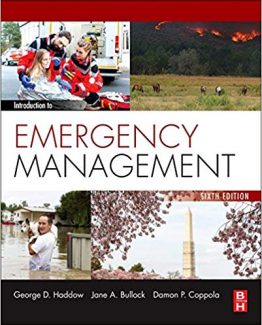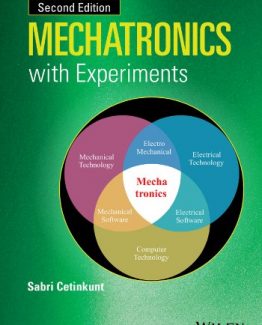Modern Control Engineering 5th Edition by Katsuhiko Ogata, ISBN-13: 978-0136156734
[PDF eBook eTextbook]
- Publisher: Pearson; 5th edition (August 25, 2009)
- Language: English
- 912 pages
- ISBN-10: 0136156738
- ISBN-13: 978-0136156734
For senior or graduate-level students taking a first course in Control Theory (in departments of Mechanical, Electrical, Aerospace, and Chemical Engineering).
Table of Contents:
Contents
Preface
Chapter 1 Introduction to Control Systems
1–1 Introduction
1–2 Examples of Control Systems
1–3 Closed-Loop Control Versus Open-Loop Control
1–4 Design and Compensation of Control Systems
1–5 Outline of the Book
Chapter 2 Mathematical Modeling of Control Systems
2–1 Introduction
2–2 Transfer Function and Impulse-Response Function
2–3 Automatic Control Systems
2–4 Modeling in State Space
2–5 State-Space Representation of Scalar Differential Equation Systems
2–6 Transformation of Mathematical Models with MATLAB
2–7 Linearization of Nonlinear Mathematical Models
Example Problems and Solutions
Problems
Chapter 3 Mathematical Modeling of Mechanical Systems and Electrical Systems
3–1 Introduction
3–2 Mathematical Modeling of Mechanical Systems
3–3 Mathematical Modeling of Electrical Systems
Example Problems and Solutions
Problems
Chapter 4 Mathematical Modeling of Fluid Systems and Thermal Systems
4–1 Introduction
4–2 Liquid-Level Systems
4–3 Pneumatic Systems
4–4 Hydraulic Systems
4–5 Thermal Systems
Example Problems and Solutions
Problems
Chapter 5 Transient and Steady-State Response Analyses
5–1 Introduction
5–2 First-Order Systems
5–3 Second-Order Systems
5–4 Higher-Order Systems
5–5 Transient-Response Analysis with MATLAB
5–6 Routh’s Stability Criterion
5–7 Effects of Integral and Derivative Control Actions on System Performance
5–8 Steady-State Errors in Unity-Feedback Control Systems
Example Problems and Solutions
Problems
Chapter 6 Control Systems Analysis and Design by the Root-Locus Method
6–1 Introduction
6–2 Root-Locus Plots
6–3 Plotting Root Loci with MATLAB
6–4 Root-Locus Plots of Positive Feedback Systems
6–5 Root-Locus Approach to Control-Systems Design
6–6 Lead Compensation
6–7 Lag Compensation
6–8 Lag–Lead Compensation
6–9 Parallel Compensation
Example Problems and Solutions
Problems
Chapter 7 Control Systems Analysis and Design by the Frequency-Response Method
7–1 Introduction
7–2 Bode Diagrams
7–3 Polar Plots
7–4 Log-Magnitude-versus-Phase Plots
7–5 Nyquist Stability Criterion
7–6 Stability Analysis
7–7 Relative Stability Analysis
7–8 Closed-Loop Frequency Response of Unity-Feedback Systems
7–9 Experimental Determination of Transfer Functions
7–10 Control Systems Design by Frequency-Response Approach
7–11 Lead Compensation
7–12 Lag Compensation
7–13 Lag–Lead Compensation
Example Problems and Solutions
Problems
Chapter 8 PID Controllers and Modified PID Controllers
8–1 Introduction
8–2 Ziegler–Nichols Rules for Tuning PID Controllers
8–3 Design of PID Controllers with Frequency-Response Approach
8–4 Design of PID Controllers with Computational Optimization Approach
8–5 Modifications of PID Control Schemes
8–6 Two-Degrees-of-Freedom Control
8–7 Zero-Placement Approach to Improve Response Characteristics
Example Problems and Solutions
Problems
Chapter 9 Control Systems Analysis in State Space
9–1 Introduction
9–2 State-Space Representations of Transfer-Function Systems
9–3 Transformation of System Models with MATLAB
9–4 Solving the Time-Invariant State Equation
9–5 Some Useful Results in Vector-Matrix Analysis
9–6 Controllability
9–7 Observability
Example Problems and Solutions
Problems
Chapter 10 Control Systems Design in State Space
10–1 Introduction
10–2 Pole Placement
10–3 Solving Pole-Placement Problems with MATLAB
10–4 Design of Servo Systems
10–5 State Observers
10–6 Design of Regulator Systems with Observers
10–7 Design of Control Systems with Observers
10–8 Quadratic Optimal Regulator Systems
10–9 Robust Control Systems
Example Problems and Solutions
Problems
Appendix A: Laplace Transform Tables
Appendix B: Partial-Fraction Expansion
Appendix C: Vector-Matrix Algebra
References
Index
Dr. Katsuhiko Ogata graduated from the University of Tokyo (BS), earned an MS degree from the University of Illinois, and his Ph.D from the University of California, Berkeley. He is Professor Emeritus at the University of Minnesota.
What makes us different?
• Instant Download
• Always Competitive Pricing
• 100% Privacy
• FREE Sample Available
• 24-7 LIVE Customer Support






Reviews
There are no reviews yet.